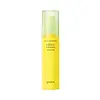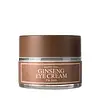What's inside
What's inside
 Key Ingredients
Key Ingredients

 Benefits
Benefits

 Concerns
Concerns

No concerns
 Ingredients Side-by-side
Ingredients Side-by-side

Citrus Tangerina Extract
TonicButylene Glycol
HumectantGlycerin
HumectantPropanediol
SolventWater
Skin ConditioningPentaerythrityl Tetraethylhexanoate
EmollientPentylene Glycol
Skin ConditioningNiacinamide
SmoothingArbutin
Antioxidant1,2-Hexanediol
Skin ConditioningPolymethylsilsesquioxane
Diisostearyl Malate
EmollientVinyldimethicone
3-O-Ethyl Ascorbic Acid
Skin ConditioningAscorbic Acid Polypeptide
AntioxidantChlorella Vulgaris Extract
Skin ConditioningMelia Azadirachta Flower Extract
Skin ConditioningMelia Azadirachta Leaf Extract
Skin ConditioningCurcuma Longa Root Extract
MaskingOcimum Sanctum Leaf Extract
Skin ConditioningCorallina Officinalis Extract
Skin ConditioningDiglycerin
HumectantCaprylic/Capric/Myristic/Stearic Triglyceride
EmollientMethyl Methacrylate Crosspolymer
Sodium Polyacryloyldimethyl Taurate
Emulsion StabilisingAmmonium Acryloyldimethyltaurate/Beheneth-25 Methacrylate Crosspolymer
Emulsion StabilisingBis-Diglyceryl Polyacyladipate-2
EmollientGlucose
HumectantDimethiconol
EmollientAcrylates/C10-30 Alkyl Acrylate Crosspolymer
Emulsion StabilisingHydroxyacetophenone
AntioxidantTromethamine
BufferingFructooligosaccharides
HumectantFructose
HumectantGlucosyl Hesperidin
HumectantEthylhexylglycerin
Skin ConditioningGlyceryl Acrylate/Acrylic Acid Copolymer
HumectantAllantoin
Skin ConditioningDipotassium Glycyrrhizate
HumectantAdenosine
Skin ConditioningTocopherol
AntioxidantDisodium EDTA
Citrus Tangerina Extract, Butylene Glycol, Glycerin, Propanediol, Water, Pentaerythrityl Tetraethylhexanoate, Pentylene Glycol, Niacinamide, Arbutin, 1,2-Hexanediol, Polymethylsilsesquioxane, Diisostearyl Malate, Vinyldimethicone, 3-O-Ethyl Ascorbic Acid, Ascorbic Acid Polypeptide, Chlorella Vulgaris Extract, Melia Azadirachta Flower Extract, Melia Azadirachta Leaf Extract, Curcuma Longa Root Extract, Ocimum Sanctum Leaf Extract, Corallina Officinalis Extract, Diglycerin, Caprylic/Capric/Myristic/Stearic Triglyceride, Methyl Methacrylate Crosspolymer, Sodium Polyacryloyldimethyl Taurate, Ammonium Acryloyldimethyltaurate/Beheneth-25 Methacrylate Crosspolymer, Bis-Diglyceryl Polyacyladipate-2, Glucose, Dimethiconol, Acrylates/C10-30 Alkyl Acrylate Crosspolymer, Hydroxyacetophenone, Tromethamine, Fructooligosaccharides, Fructose, Glucosyl Hesperidin, Ethylhexylglycerin, Glyceryl Acrylate/Acrylic Acid Copolymer, Allantoin, Dipotassium Glycyrrhizate, Adenosine, Tocopherol, Disodium EDTA
Water
Skin ConditioningButylene Glycol
HumectantCaprylic/Capric Triglyceride
MaskingGlycerin
HumectantPanax Ginseng Root Extract
EmollientCetearyl Olivate
Simmondsia Chinensis Seed Oil
EmollientButyrospermum Parkii Butter
Skin ConditioningCetearyl Alcohol
EmollientSorbitan Olivate
EmulsifyingBeeswax
Emulsion StabilisingMethylpropanediol
SolventHydroxyethyl Acrylate/Sodium Acryloyldimethyl Taurate Copolymer
Emulsion StabilisingIsododecane
EmollientBetaine
HumectantHexanediol
SolventDimethicone
EmollientDimethicone/Vinyl Dimethicone Crosspolymer
Skin ConditioningGlyceryl Caprylate
EmollientSoluble Collagen
HumectantDipotassium Glycyrrhizate
HumectantAllantoin
Skin ConditioningAdenosine
Skin ConditioningDisodium EDTA
Pulsatilla Koreana Extract
Skin ConditioningZanthoxylum Piperitum Fruit Extract
Skin ConditioningEthylhexylglycerin
Skin ConditioningSorbitan Isostearate
EmulsifyingSqualane
EmollientSodium Acetylated Hyaluronate
HumectantHydrolyzed Hyaluronic Acid
HumectantBoswellia Serrata Resin Extract
SmoothingWater, Butylene Glycol, Caprylic/Capric Triglyceride, Glycerin, Panax Ginseng Root Extract, Cetearyl Olivate, Simmondsia Chinensis Seed Oil, Butyrospermum Parkii Butter, Cetearyl Alcohol, Sorbitan Olivate, Beeswax, Methylpropanediol, Hydroxyethyl Acrylate/Sodium Acryloyldimethyl Taurate Copolymer, Isododecane, Betaine, Hexanediol, Dimethicone, Dimethicone/Vinyl Dimethicone Crosspolymer, Glyceryl Caprylate, Soluble Collagen, Dipotassium Glycyrrhizate, Allantoin, Adenosine, Disodium EDTA, Pulsatilla Koreana Extract, Zanthoxylum Piperitum Fruit Extract, Ethylhexylglycerin, Sorbitan Isostearate, Squalane, Sodium Acetylated Hyaluronate, Hydrolyzed Hyaluronic Acid, Boswellia Serrata Resin Extract
 Reviews
Reviews

Ingredients Explained
These ingredients are found in both products.
Ingredients higher up in an ingredient list are typically present in a larger amount.
Adenosine is in every living organism. It is one of four components in nucleic acids that helps store our DNA.
Adenosine has many benefits when used. These benefits include hydrating the skin, smoothing skin, and reducing wrinkles. Once applied, adenosine increases collagen production. It also helps with improving firmness and tissue repair.
Studies have found adenosine may also help with wound healing.
In skincare products, Adenosine is usually derived from yeast.
Learn more about AdenosineAllantoin is a soothing ingredient known for its protective and moisturizingg properties. Because of this, it is often added to products with strong active ingredients.
Studies show higher concentrations of this ingredient can promote wound healing.
Though it can be derived from the comfrey plant, allantoin is produced synthetically for cosmetic products to ensure purity.
Learn more about AllantoinButylene Glycol (or BG) is used within cosmetic products for a few different reasons:
Overall, Butylene Glycol is a safe and well-rounded ingredient that works well with other ingredients.
Though this ingredient works well with most skin types, some people with sensitive skin may experience a reaction such as allergic rashes, closed comedones, or itchiness.
Learn more about Butylene GlycolDipotassium Glycyrrhizate comes from licorice root.
Extracts of licorice have demonstrated to have antibacterial, anti‐inflammatory, antiviral, antioxidant properties.
One component, glabridin, has extra potent antioxidant and soothing properties. It has also been found to block pigmentation from UVB rays in guinea pigs.
Licorice Root also contains a flavonoid. Flavonoids are a natural substance from in plants. Flavonoids also have antioxidant properties.
Another component, glycyrrhizin, has been found to have anti-inflammatory and antimicrobial benefits. This may make licorice root extract effective at treating acne. However, more research is needed to support this.
Liquiritin is one of the flavone compounds found in licorice. It has been found to help lighten skin by preventing tyrosinase from reacting with tyrosine. When the two react, protein is converted to melanin. Melanin is the substance in your body that gives your features pigmentation.
Licorice root is native to Southern Europe and Asia. It has been used in traditional Chinese medicine to help with respiratory issues.
Learn more about Dipotassium GlycyrrhizateDisodium EDTA plays a role in making products more stable by aiding other preservatives.
It is a chelating agent, meaning it neutralizes metal ions that may be found in a product.
Disodium EDTA is a salt of edetic acid and is found to be safe in cosmetic ingredients.
Learn more about Disodium EDTAEthylhexylglycerin (we can't pronounce this either) is commonly used as a preservative and skin softener. It is derived from glyceryl.
You might see Ethylhexylglycerin often paired with other preservatives such as phenoxyethanol. Ethylhexylglycerin has been found to increase the effectiveness of these other preservatives.
Glycerin is already naturally found in your skin. It helps moisturize and protect your skin.
A study from 2016 found glycerin to be more effective as a humectant than AHAs and hyaluronic acid.
As a humectant, it helps the skin stay hydrated by pulling moisture to your skin. The low molecular weight of glycerin allows it to pull moisture into the deeper layers of your skin.
Hydrated skin improves your skin barrier; Your skin barrier helps protect against irritants and bacteria.
Glycerin has also been found to have antimicrobial and antiviral properties. Due to these properties, glycerin is often used in wound and burn treatments.
In cosmetics, glycerin is usually derived from plants such as soybean or palm. However, it can also be sourced from animals, such as tallow or animal fat.
This ingredient is organic, colorless, odorless, and non-toxic.
Glycerin is the name for this ingredient in American English. British English uses Glycerol/Glycerine.
Learn more about GlycerinWater. It's the most common cosmetic ingredient of all. You'll usually see it at the top of ingredient lists, meaning that it makes up the largest part of the product.
So why is it so popular? Water most often acts as a solvent - this means that it helps dissolve other ingredients into the formulation.
You'll also recognize water as that liquid we all need to stay alive. If you see this, drink a glass of water. Stay hydrated!
Learn more about Water